King Tut's Golden Shrines
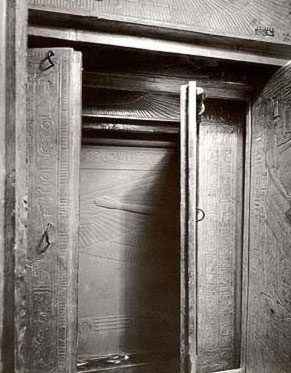 Just
behind the blocking of the Burial Chamber entrance in the
Tomb of Tutankhamun, Howard Carter and his assistants were
met by what appeared to be a wall of gilded wood inlaid with
dazzling blue faience. What they were actually seeing was
the outermost of a group of nested shrines that protected
the king's sarcophagus. It was a carefully built construct
mostly built of cedar and held together by tenons of oak,
Christ's Thorn wood and bronze. Within this shrine were contained
a pall frame, a second, third and fourth inner shrine and
then the sarcophagus.
Just
behind the blocking of the Burial Chamber entrance in the
Tomb of Tutankhamun, Howard Carter and his assistants were
met by what appeared to be a wall of gilded wood inlaid with
dazzling blue faience. What they were actually seeing was
the outermost of a group of nested shrines that protected
the king's sarcophagus. It was a carefully built construct
mostly built of cedar and held together by tenons of oak,
Christ's Thorn wood and bronze. Within this shrine were contained
a pall frame, a second, third and fourth inner shrine and
then the sarcophagus.
Each shrine was copper-bound at its lower edge and
fitted at its eastern end with double folding doors. The doors
were held shut by ebony bolts sliding within massive, silver-coated
staples. Two other staples on each door were intended to receive
a cord binding and seal. However, on the outermost shrine,
neither the cord nor the sealing was present, though on the
second and third shrines, these corded seals not only remained,
but were intact. The door of the fourth (innermost) shrine
had never been sealed.
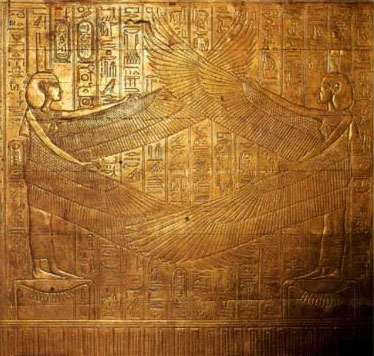 These
shrines were extremely fragile when discovered by Carter.
Their gilded gesso surfaces had parted in places due to the
shrinkage of the base wood. Furthermore, the shrines so closely
filled the confines of this hot, stuffy chamber that their
disassembly into 51 sections, some weighing as much as half
a ton, and their removal from the tomb was no easy task. According
to Howard Carter, "We bumped our heads, nipped our fingers,
we had to squeeze in and out like weasels, and work in all
kinds of embarrassing positions". Not until the end of the
second season, after "eighty-four days of real manual labour",
was the work of dismantling completed. At that point the panels
of the shrines lay propped against the walls of the Burial
Chamber, while their roof sections were in the Antechamber
of the tomb. Conservation began in 1928, which used up over
half a ton of paraffin wax. Only two seasons later were the
shrines strong enough to be transported to the Cairo Museum
where they could be properly examined.
These
shrines were extremely fragile when discovered by Carter.
Their gilded gesso surfaces had parted in places due to the
shrinkage of the base wood. Furthermore, the shrines so closely
filled the confines of this hot, stuffy chamber that their
disassembly into 51 sections, some weighing as much as half
a ton, and their removal from the tomb was no easy task. According
to Howard Carter, "We bumped our heads, nipped our fingers,
we had to squeeze in and out like weasels, and work in all
kinds of embarrassing positions". Not until the end of the
second season, after "eighty-four days of real manual labour",
was the work of dismantling completed. At that point the panels
of the shrines lay propped against the walls of the Burial
Chamber, while their roof sections were in the Antechamber
of the tomb. Conservation began in 1928, which used up over
half a ton of paraffin wax. Only two seasons later were the
shrines strong enough to be transported to the Cairo Museum
where they could be properly examined.
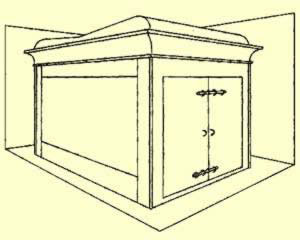 Outer
Shrine (no. 207)
Outer
Shrine (no. 207)
The first shrine that Carter saw, the outermost one,
measures 5.08 by 3.28 meters and was 2.75 meters (about 9
feet) high. With its battered walls and double-sloping roof,
it bears a striking resemblance to the sed-festival pavilion
in which the king achieved rejuvenation and rebirth. However,
in Carter's view, the shape was chosen just as much for aesthetics
as for ritual requirements.
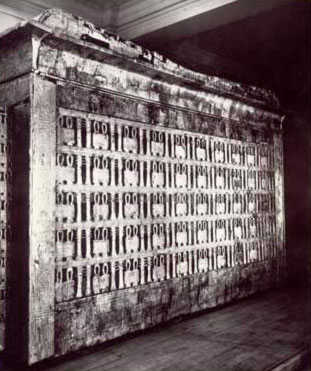 It
was built of heavy cedar panels some 32 millimeters thick.
Both the inside and outside of these panels were gessoed,
gilded and inlaid. The sides and rear panel of the shrine
are decorated with double tyet-knot amulets of Isis and djed
(stability) hieroglyphs of Osiris, all set against a brilliant
blue faience background. A pair of protective Wadjet-eyes
decorate what was intended to be the shrine's north side,
but as erected these eyes actually faced south. The two doors
are each adorned with a rectangular panel with sunk reliefs.
The one on the left depicts a headless and pawless leonine
creature, while the one on the right has a seated divinity
with twin feather headdress, grasping an ankh (life) sign.
It
was built of heavy cedar panels some 32 millimeters thick.
Both the inside and outside of these panels were gessoed,
gilded and inlaid. The sides and rear panel of the shrine
are decorated with double tyet-knot amulets of Isis and djed
(stability) hieroglyphs of Osiris, all set against a brilliant
blue faience background. A pair of protective Wadjet-eyes
decorate what was intended to be the shrine's north side,
but as erected these eyes actually faced south. The two doors
are each adorned with a rectangular panel with sunk reliefs.
The one on the left depicts a headless and pawless leonine
creature, while the one on the right has a seated divinity
with twin feather headdress, grasping an ankh (life) sign.
In opposed to the exterior, the inside surfaces of
the shrine are heavily inscribed with extracts from the Book
of the Dead, spells 1, 134 and 141-2, and also from the Book
of the Divine Cow (the legend of the Destruction of Mankind).
The inside of the roof, the middle section of which was incorrectly
inversed, is decorated with winged solar discs and 13 vultures.
Linen Pall (no. 209)
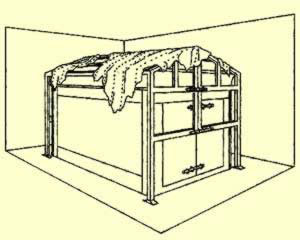 Situated
between the outer shrine and the first inner shrine was poorly
constructed, nine-piece gabled framework of gessoed, varnished
and gilded wood measuring 4.32 by 2.93 meters. It stood 2.78
meters high. Over this framework had been carelessly spread
a coarsely woven, dark brown linen pall, itself measuring
5.5 by 4.4 meters. It was actually made up of several widths
of material that were sewn together.
Situated
between the outer shrine and the first inner shrine was poorly
constructed, nine-piece gabled framework of gessoed, varnished
and gilded wood measuring 4.32 by 2.93 meters. It stood 2.78
meters high. Over this framework had been carelessly spread
a coarsely woven, dark brown linen pall, itself measuring
5.5 by 4.4 meters. It was actually made up of several widths
of material that were sewn together.
Decorating the cloth were large, 4.7 centimeter marguerites
of gilded bronze which had been sewn onto the fabric at intervals
of 19.5 and 22 centimeters. J. H. Breasted thought that this
pall was "like a night sky spangled with stars." Regrettably,
while Carter and his team had expended considerable time and
ingenuity trying to preserve this extremely fragile item,
which had torn apart 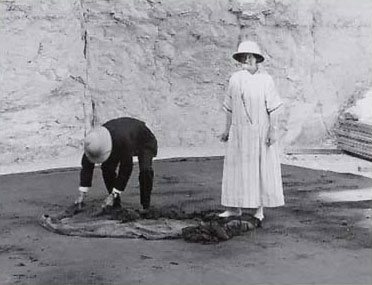 from
the weight of its bronze sequins, it suffered extensive damage
due to its having been left out in the open during the period
that the American team was locked out of the tomb and laboratory
(See the politics of the King Tut excavation). While Carter
was extremely agitated on discovering the ruined condition
of the fabric upon his return to work, he limited his remarks
by saying that, "Well, anyway, it's your pall, not mine, and
it's the only one in the world."
from
the weight of its bronze sequins, it suffered extensive damage
due to its having been left out in the open during the period
that the American team was locked out of the tomb and laboratory
(See the politics of the King Tut excavation). While Carter
was extremely agitated on discovering the ruined condition
of the fabric upon his return to work, he limited his remarks
by saying that, "Well, anyway, it's your pall, not mine, and
it's the only one in the world."
The Second Outermost Shrine (no. 237)
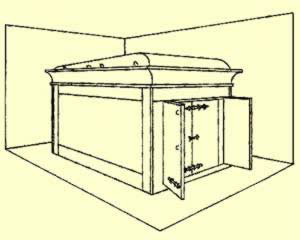 The
second outermost shrine was different from the first both
in its dimensions (3.75 meters deep by 2.35 meters wide by
2.25 meters high) and in its shape. Unlike that of the outermost
shrine, the second shrine had a sloping roof which reached
its maximum height above the entrance doors. The shrine appears
to imitate, in its basic form, the shape of the Per-wer, the
ancient shrine of Upper Egypt.
The
second outermost shrine was different from the first both
in its dimensions (3.75 meters deep by 2.35 meters wide by
2.25 meters high) and in its shape. Unlike that of the outermost
shrine, the second shrine had a sloping roof which reached
its maximum height above the entrance doors. The shrine appears
to imitate, in its basic form, the shape of the Per-wer, the
ancient shrine of Upper Egypt.
This shrine was made of 16 heavy wooden sections.
Most of the surfaces, both inside and out, had been gessoed
and covered with a layer of gold leaf. The roof was covered
with thick black resin divided into squares by gilded bands
of incised decoration. The exterior surface of each door was
adorned with a superbly crafted depiction of the king before
Osiris (left) and Re-Horakhty (right), executed in sunk relief.
On the back of the shrine stand Isis and Nephthys, who as
the sisters of Osiris would have been the principal mourners
at the deified king's funeral. The remainder of the outer
surface is decorated with texts and vignettes from various
funerary compositions, including the Book of the Dead spells
1, 17, 26, 27 and 28, as well as a unique cryptographic funerary
book which has as its theme the triumph of light.
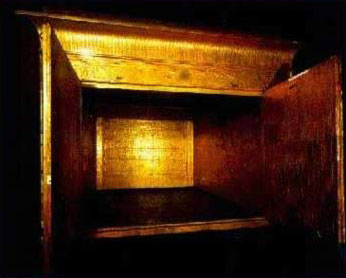 Inside,
the decorative theme of this shrine is dominated by a figure
of the winged sky-goddess Nut surmounting the hieroglyph for
"gold" which, together with five vultures having outspread
wings, decorates the ceiling. To either side of the goddess
are spells from the Pyramid Texts and the Book of the Dead.
The inside surface of the right-hand door carries a depiction
of a donkey-headed herald and a ram-headed guardian of the
underworld, while that of the left door panel carries a similar
underworld guardian and a human-headed figure wearing a close-fitting
cap. Above is text from spell 144 of the Book of the Dead,
invoking the keepers of the gates of the underworld.
Inside,
the decorative theme of this shrine is dominated by a figure
of the winged sky-goddess Nut surmounting the hieroglyph for
"gold" which, together with five vultures having outspread
wings, decorates the ceiling. To either side of the goddess
are spells from the Pyramid Texts and the Book of the Dead.
The inside surface of the right-hand door carries a depiction
of a donkey-headed herald and a ram-headed guardian of the
underworld, while that of the left door panel carries a similar
underworld guardian and a human-headed figure wearing a close-fitting
cap. Above is text from spell 144 of the Book of the Dead,
invoking the keepers of the gates of the underworld.
The right and left side panels of the shrine are
decorated with sunk-relief vignettes illustrating the Book
of the Dead spell 148 (the seven celestial cows, the bull
of heaven and the four rudders of heaven). Another vignette
depicts spells 141-2, with additional texts from spells 130,
133, 134 and 148. The back panel of the shrine is inscribed
in finely delineated hieroglyphs with Book of the Dead spell
17, a statement of the solar doctrine.
One interesting feature of this shrine is that it
has been re-inscribed. The more brilliant gilding of the cartouches
reveals that the nomen "Tutankhamun" was written over an original
name, a component part of which, according to Carter, was
'-aten."
The Third Outer Shrine (no. 238)
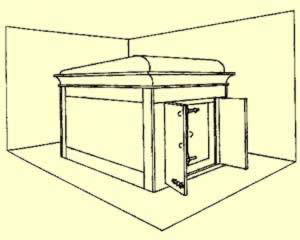 The
third outer shrine is very similar in form to the second,
with a sloping roof and, of course, somewhat smaller dimensions.
It was 3.4 meters long by 1.92 meters wide with a maximum
height of 2.15 meters.
The
third outer shrine is very similar in form to the second,
with a sloping roof and, of course, somewhat smaller dimensions.
It was 3.4 meters long by 1.92 meters wide with a maximum
height of 2.15 meters.
This structure was built using ten separate sections,
and like the first shrine, it is gilded over its entire surface
and decorated in sunk relief with vignettes and extracts from
various Egyptian funerary texts. The roof of the third outer
shrine depicts a winged 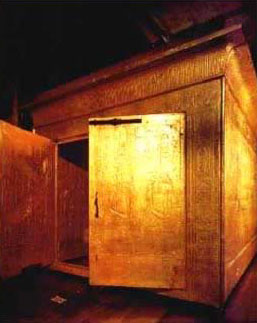 solar
disc and a vertical row of eight spread-winged birds, including
four vultures, two mythical serpent-headed vultures and two
falcons. The sides of the shrine are inscribed with abridged
versions of the second and sixth divisions of the Book of
What Is in the Underworld (the Amduat). The outer faces of
the doors and the back panel of the shrine are inscribed with
extracts from spell 148 of the Book of the Dead, and are adorned
with four ram-headed guardian figures and four heralds, each
grasping one or two knives, and variously represented as human-headed,
antelope-headed or crocodile-headed.
solar
disc and a vertical row of eight spread-winged birds, including
four vultures, two mythical serpent-headed vultures and two
falcons. The sides of the shrine are inscribed with abridged
versions of the second and sixth divisions of the Book of
What Is in the Underworld (the Amduat). The outer faces of
the doors and the back panel of the shrine are inscribed with
extracts from spell 148 of the Book of the Dead, and are adorned
with four ram-headed guardian figures and four heralds, each
grasping one or two knives, and variously represented as human-headed,
antelope-headed or crocodile-headed.
The decorative theme of the top of this shrine is
balanced on the side of the roof with a similar decoration,
consisting of a winged disc, five vultures, a serpent-headed
vulture, a sixth vulture and a falcon. The inner walls of
the shrine are decorated with processions of various gods,
while on the inside door panels and end are shown Isis and
Nephthys, their wings again outspread to protect King Tut.
The Innermost Shrine (no. 239)
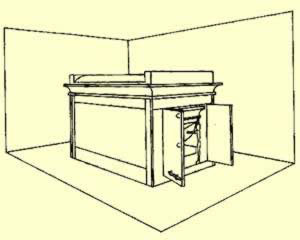 The
final, innermost of King Tut's four shrines measures 2.90
meters deep by 1.48 meters wide and 1.9 meters high. It was
constructed from only five separate sections. We believe that
it is a reconstruction in miniature of the prehistoric "Palace
of the North", the Per-nu. Its has a barrel-vaulted roof,
decorated in bas relief with kneeling figures of Isis, Nephthys,
Selkis and Neith, alternating with Wadjet-eyes, recumbent
Anubis dogs and vultures, each on a pylon. The right and left
side panels depict, respectively, a procession of Imsety,
Anubis, Duamutef and Geb, and Hapy, Anubis, Qebhsenuef and
Horus between figures of Thoth supporting the sky. The end
panel and the outside door panels show protective images of
the winged Isis and her sister, Nephythys.
The
final, innermost of King Tut's four shrines measures 2.90
meters deep by 1.48 meters wide and 1.9 meters high. It was
constructed from only five separate sections. We believe that
it is a reconstruction in miniature of the prehistoric "Palace
of the North", the Per-nu. Its has a barrel-vaulted roof,
decorated in bas relief with kneeling figures of Isis, Nephthys,
Selkis and Neith, alternating with Wadjet-eyes, recumbent
Anubis dogs and vultures, each on a pylon. The right and left
side panels depict, respectively, a procession of Imsety,
Anubis, Duamutef and Geb, and Hapy, Anubis, Qebhsenuef and
Horus between figures of Thoth supporting the sky. The end
panel and the outside door panels show protective images of
the winged Isis and her sister, Nephythys.
The ceiling of this shrine is adorned with a magnificent
representation of the goddess Nut, again with outspread wings,
flanked by the falcon-headed Horus. Once more, Isis.and Nephthys
guard the doors, while the interior wall panels carry the
text of spell 17 from the Book of the Dead.
The Sarcophagus
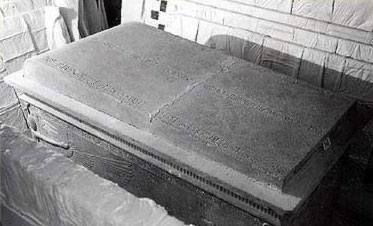
The Sarcophagus of King Tut, with its cracked lid
The sarcophagus measures 2.74 meters long by 1.47
meters wide and is 1.47 meters high. It was carved from a
single block of the hardest quartzite and was supported at
each corner upon a block of calcite (alabaster). According
the J. H. Breasted:
"When Carter and I opened the doors of the third
and fourth shrines and beheld the massive stone sarcophagus
within, I felt for the first time the majesty of the dead
Pharaoh's actual presence."
The sloping lid of the sarcophagus, with its winged
sun disc at the head end and three vertical columns of incised
hieroglyphs, was made of red granite, painted to match the
yellow of the sarcophagus box. Obviously, the lid was 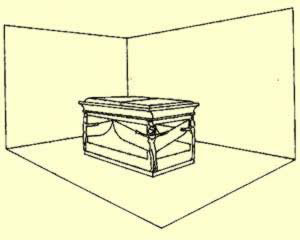 not
a match to the box, and Carter suggested that it was possibly
a replacement for the intended lid, which had not been ready
in time for the funeral. The lid was even cracked across the
center, perhaps due to some accident at the time of its hurried
installation. This crack was then filled with gypsum, which
was itself touched up to blend in with the new color of the
lid.
not
a match to the box, and Carter suggested that it was possibly
a replacement for the intended lid, which had not been ready
in time for the funeral. The lid was even cracked across the
center, perhaps due to some accident at the time of its hurried
installation. This crack was then filled with gypsum, which
was itself touched up to blend in with the new color of the
lid.
The decorative theme of the sarcophagus is dominated
by the four tutelary deities, Isis, Nephthys, Selkis and Neith,
carved in high relief to the traditional proportions of the
Pre-Amarna, 18-square grid and delicately picked out in colors.
They stand at each of the four corners of the sarcophagus
box, their winged arms outstretched to envelop the box in
a protective embrace. The box has a cavetto cornice at the
top 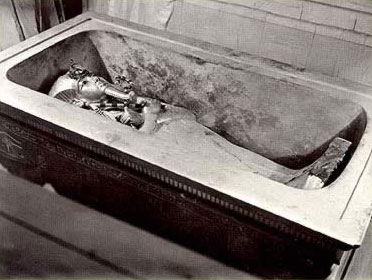 edge,
which is balanced at the bottom by a dado of double tyet and
djed amuletes. Each long side of the sarcophagus is adorned
with one horizontal and six vertical columns of deeply incised
hieroglyphs and at its westernmost end is an incised Wadjet-eye.
The east and west ends of the box are similarly inscribed
with a single horizontal band of text and fourteen vertical
texts.
edge,
which is balanced at the bottom by a dado of double tyet and
djed amuletes. Each long side of the sarcophagus is adorned
with one horizontal and six vertical columns of deeply incised
hieroglyphs and at its westernmost end is an incised Wadjet-eye.
The east and west ends of the box are similarly inscribed
with a single horizontal band of text and fourteen vertical
texts.
Carter says that "the crack (in the lid) greatly
complicated our final effort, the raising of (the sarcophagus)
lid." However, by passing angle irons beneath the long edges
of the lid, permitting "it to be raised by differential pulleys
as one piece", the difficulty was resolved. On February 12th,
1924, the tackle was brought into play. The ropes tightened
and the ton and and a quarter granite lid slowly lifted into
the air. According to J. H. Breasted:
"The sarcophagus lid trembled, began to
rise. Slowly, and swaying uncertainly, it swung clear.
At first we saw only a long, narrow, black void.
Then across the middle of this blackness we gradually discerned
fragments of granite which had fallen out of the fracture
in the lid. They were lying scattered upon a dark shroud
through which we seemed to see emerging an indistinct form...."
See also: